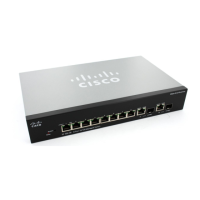Configuring SNMP
Defining Trap Settings
Cisco Small Business 300 Series Managed Switch Administration Guide 290
19
Defining Trap Settings
The
Trap Settings Page
enables configuring whether SNMP notifications are sent
from the switch, and for which cases. The recipients of the SNMP notifications can
be configured in the SNMPv1,2 Notification Recipient Page, or the
SNMPv3
Notification Recipient Page
.
To define trap settings:
STEP 1 Click SNMP > Trap Settings. The
Trap Settings Page
opens.
STEP 2 Select Enable for SNMP Notifications to specify that the switch can send SNMP
notifications.
STEP 3 Select Enable for Authentication Notifications to enable SNMP authentication
failure notification.
STEP 4 Click Apply. The SNMP Trap settings are defined, and the switch is updated.
Notification Recipients
Trap messages are generated to report system events, as defined in RFC 1215.
The system can generate traps defined in the MIB that it supports.
Trap receivers (aka Notification Recipients) are network nodes where the trap
messages are sent by the switch. A list of trap receivers is defined as the targets
of trap messages.
A trap receiver entry contains the IP address of the node and the SNMP
credentials corresponding to the version that will be included in the trap message.
When an event arises that requires a trap message to be sent, it is sent to every
node listed in the trap receiver list.
The
SNMPv1,2 Notification Recipient Page
and the
SNMPv3 Notification Recipient
Page
enable
configuring the destination to which SNMP notifications are sent, and
the types of SNMP notifications that are sent to each destination (traps or informs).
The Add/Edit pop-ups enable configuring the attributes of the notifications.
An SNMP notification is a message sent from the switch to the SNMP management
station indicating that a certain event has occurred, such as a link up/down.

